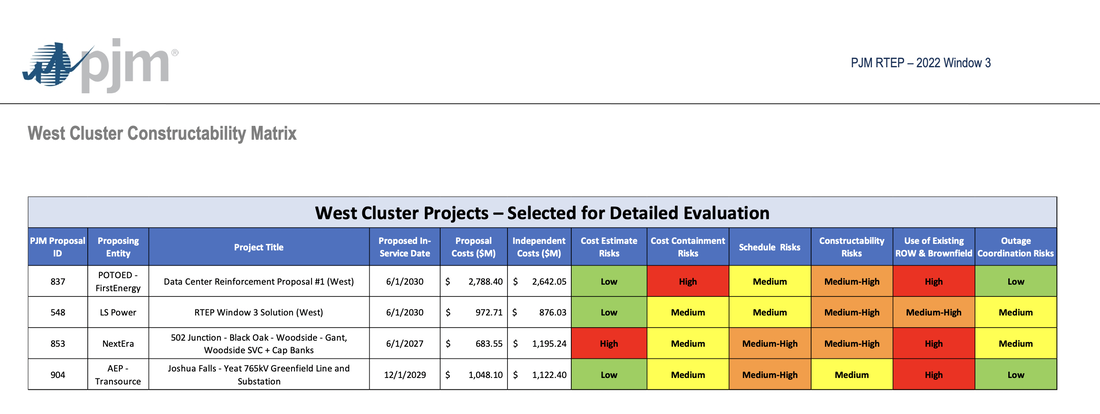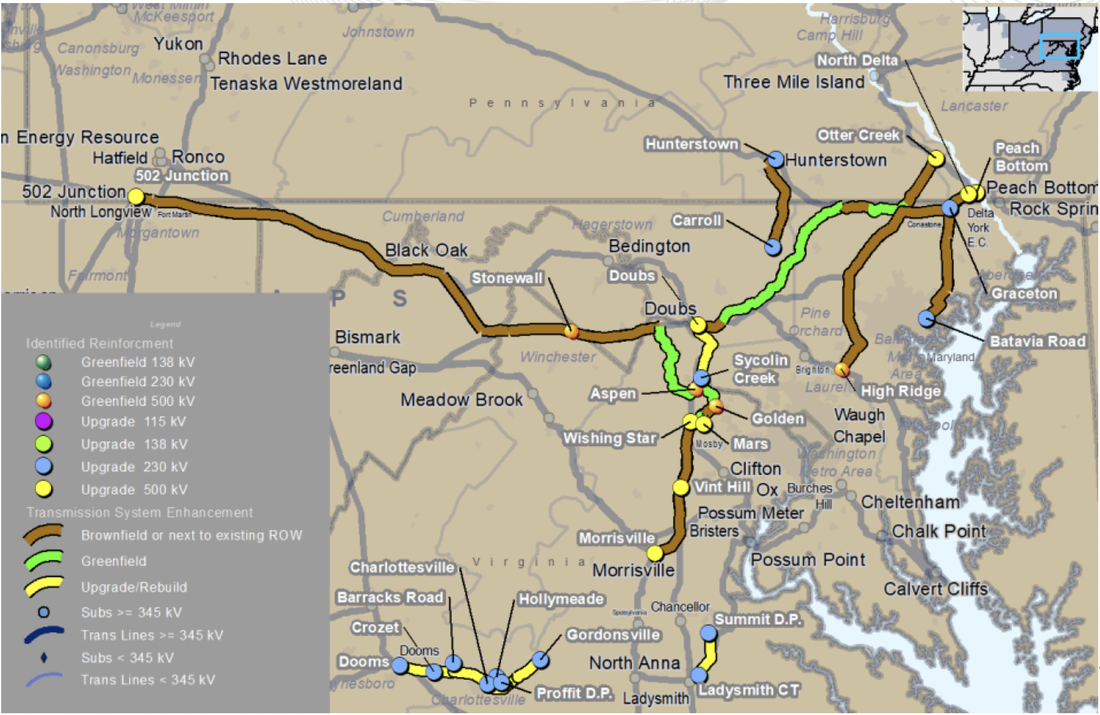Constructability (or buildability) is a concept that denotes ease of construction. It can be central to project management techniques to review construction processes from start to finish during pre-construction phase. Buildability assessment is employed to identify obstacles before a project is actually built to reduce or prevent errors, delays, and cost overruns.
Here's PJM's Constructability and Financial Analysis Report. I didn't expect it to be anywhere near correct or accurate, and I wasn't disappointed. It's completely illogical to the point of demonstrating bias. Why is it that PJM has selected some of the most risky projects to recommend for approval by its Board of Managers? Here's what I mean (see page 115 of the report for larger image):
What is proposal 904? It's the building of a new 765kV transmission line through a section of central Virginia. 904 connects the data centers to a huge inventory of fossil fuel generators in the Ohio River Valley using AEP's 765kV transmission network. Significantly, proposal 904 keeps all the transmission necessary to serve Virginia's new data center build in Virginia. The other proposals inflict the burden of serving Virginia's data centers on other surrounding states. Keep that in mind as we examine these two competing proposals as PJM did in its Constructability report.
Project 853
Overall, the ROW risk for the new West cluster transmission line components in this proposal is medium-high to high, as the proposed new transmission lines are routed parallel to an existing ROW for majority of their alignment.
Environmental Risk Analysis
46a – 502 Junction to Black Oak OH 500 kV Line
Route crosses West Virginia and MD Department of Natural Resource (DNR)-recognized public lands and is also within a short distance of residential areas.
4CA – Black Oak to Woodside OH 500 kV Line
Route crosses through the Appalachian Mountains and intersects with VA Natural Heritage easements.
10C1A – Woodside to Gant (Segment 1) OH 500 kV Line
The proposed route for this line segment goes through several national scenic and historic trails (Harpers Ferry National Historical Park and the Appalachian Scenic Trail), and intersects public lands and conservation easements. This may require permission from the National Park Service (NPS) and require an Environmental Assessment (EA) pursuant to the National Environmental Policy Act (NEPA) to analyze the impacts to the environment and park resource, which could be a lengthy process. This route is also within a short distance of residential and commercial areas.
10C3 – Woodside to Gant (Segment 2) OH 500 kV Line
The proposed route for this greenfield line segment goes through highly developed residential and commercial developments, as well as state and local conservation easements. This route also crosses the Washington & Old Dominion (W&OD Trail), a regional park in northern Virginia. There is significant risk of public opposition to the proposed route, which may lead to rerouting this segment along the existing corridor from Doubs to Goose Creek.
Overall, for Proposal 853, medium-high constructability risks are assessed for the proposed line routes due to anticipated lengthy regulatory process, potential public opposition, construction difficulty, environmental constraints and property acquisition, which may have significant impacts on the cost and schedule for the proposed project.
Transmission Line Risk Analysis
Significant engineering and construction challenges are anticipated for the proposed lines to construct a total of 167 miles of new transmission through four states and will require parallel crews and construction where possible to mitigate schedule challenges that will be introduced by the anticipated lengthy permitting and land acquisition process.
For the rebuild portions of the proposed line routes, there are challenges with existing overhead transmission infrastructure components needing to be removed/salvaged before construction of proposed brownfield lines can commence, and potential design and ROW limitations for reuse of existing infrastructure/assets.
Other medium risks for this project involve the existing facility outages that will be necessary for the project, particularly for the line rebuild and substation upgrades.
Schedule Review
The proposed in-service date of June 2027 is very aggressive for the proposed scope of the project considering the significant permitting and land acquisition challenges associated with the proposed 500 kV greenfield line routes through four states. Overall, the schedule risk is considered medium-high.
Environmental Risk Analysis
Joshua Falls-Yeat 765 kV OH Line
The proposed line route has the potential to impact environmental and cultural resources including: the Southern Albemarle Rural Historic District, a FEMA High-Risk Flood Zone, wetlands and several waters subject to USACE Section 10 permitting, the most significant being the James River. The route also intersects local conservation easements and appears to co-locate with pipeline ROWs.
Warrenton-Wheeler 230 kV OH Line
The line crosses woodland, residential and agricultural parcels in Fauquier and Prince William counties in Virginia. The route intersects local conservation easements and potentially impacts environmental resources such as Auburn Battlefield Historic District, flood plains and wetlands.
There are medium constructability risks assessed for the proposed line routes due to anticipated lengthy land acquisition process, potential public opposition and environmental constraints, which will have impacts on the cost and schedule for the proposed project.
Transmission Line Risk Analysis
Transource has an optimistic schedule for several aspects of this component and would require a near perfect execution to maintain the proposed in-service date. Given the scale of the component, a 135 mile 765 kV line with everything from permitting to land acquisition to construction poses a risk for delay, the most critical being land acquisition.
For the 230 kV developments, Yeat-Clover Hill and Warrenton-Wheeler, these facilities will utilize BOLD (Breakthrough Overhead Line Design), which is a structure family developed by AEP. The design features a monopole structure with two arched crossarms to hold two circuits in a delta configuration. Benefits of BOLD include increased line capacity with lower-profile structures. However, utilizing this structure family poses risks to the schedule, specifically procurement of the arched crossarms, construction and maintenance of a non-typical design.
Schedule Review
This proposal includes 765 kV substation and transmission line construction, as well as utilization of BOLD (Breakthrough Overhead Line Design) technology for the greenfield 230 kV lines. The sum of all components is a very aggressive undertaking to be completed within the proposed schedule. The primary risks for this proposal are related to the magnitude of the scope of work, procurement and construction of 765 kV equipment and BOLD structures, state permitting and land acquisition for both the 765 kV and 230 kV developments. These all pose a medium-high risk to the December 2029 in-service date proposed by Transource.
And then there's this tidbit... did you catch it the first time you read it?
There is significant risk of public opposition to the proposed route, which may lead to rerouting this segment along the existing corridor from Doubs to Goose Creek.
So, what did we learn from PJM's constructability analysis? Not much. PJM did not examine the gray areas of opposition that I did. PJM pretty much ignored the possibility of opposition derailing their plans. Dismissed!
But, we're not going away. In fact, we're only going to get stronger. I predict that this project will NEVER get built. Maybe PJM should go back to the drawing board and take another look at project 904? Why did they dismiss that project anyhow? PJM never actually says. In fact, after reading all of PJM's excuses, err I mean analyses, I came away more convinced than ever that this whole thing is a farce. Some of the excuses for not selecting a project were so ridiculous, such as -- we didn't select this project because we selected a different project. That's not a REASON for making a project selection. I also got the idea that PJM is absolutely terrified of rich people opposition in certain areas of Northern Virginia. PJM has bowed down to the wealthy and privileged due to their bad experience trying to route the TrAIL project through those areas. PJM thinks it's a better idea to route its projects through disadvantaged areas that can't fight back (or so they think). That kind of thinking is outrageous in this day and age of environmental and energy justice reform. Add in the fact that PJM's new transmission lines are nothing but extension cords importing dirty, delicious, coal-fired electricity out of West Virginia and Pennsylvania and you've got a project idea that is dead on arrival when asking for federal help.
Stupid, stupid, stupid, on top of dumb, dumb, dumb, PJM! It's obvious PJM has another agenda at work here and it's not providing needed electric service at the lowest cost. Let's hope the PJM Board of Managers examines this farce carefully before making its decision on December 11.


 RSS Feed
RSS Feed